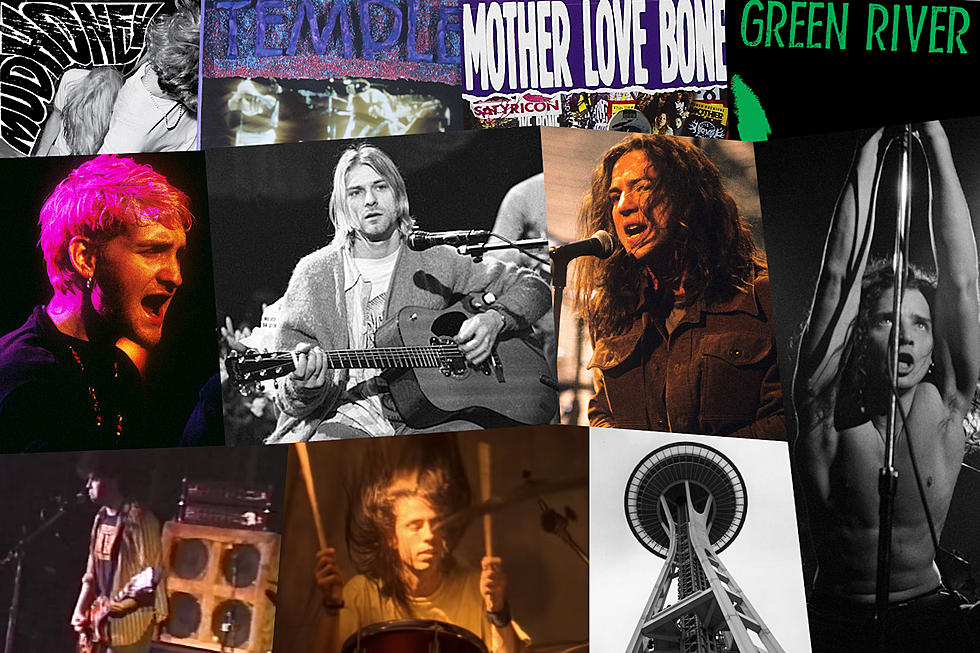
How Grunge Briefly Took Over the World
What starts a movement? It’s a complicated question that often has no one answer.
Throughout history, true movements – that is, where music, art, fashion and culture have all coalesced in a singular clear direction – have been few and far between.
Grunge, arguably the most recent societal movement, is commonly regarded as a ‘90s phenomenon, but it never would have happened without the '80s.
Ah, yes, the '80s ... hair metal, spandex, cocaine, fast cars, loose women, Ronald Reagan, power ballads, lighters in the air and enough Aqua Net to cut a hole in the ozone layer. It was an era of unfiltered decadence, but once the cultural pendulum swung so far in that direction, it was bound to reverse course.
In many ways, Seattle was the perfect breeding ground for rock’s next wave. The rainy Emerald City would never be mistaken for the glitzy Sunset Strip. Isolated in the Pacific Northwest, with logging and fishing still among its chief industries, Seattle couldn’t have felt further from the hair-metal scene.
It was also cheap. Before Starbucks, Microsoft and Amazon made it a modern-day commercial hub, Seattle was viewed by most of the U.S. as a sleepy town. Economic setbacks in the '70s kept rent prices down into the following decade, and many musicians moved there looking for a low cost of living and affordable rehearsal space.
“Seattle had been this isolated, provincial little petri dish of art and music that was allowed to kind of grow because nobody cared about it,” Chris Cornell explained to CNN in 2013.
Watch Soundgarden Perform in Seattle in 1987
The influx of raw but talented artists helped foster a burgeoning music scene. Rock clubs became some of the area’s hottest night spots, with bands regularly gigging around town in an effort to perfect their sound.
A true sense of community began to form among the artists. "There were a lot of very positive values about that culture," Sub Pop cofounder Bruce Pavitt told Spin, noting “the level of integrity, the level of camaraderie, the sense of community" in Seattle at the time. Bands shared the same bills, swapped ideas and were occasionally featured on one another’s songs.
This cross pollination gave birth to what was soon referred to as the “Seattle Sound,” later simply called grunge. Rock had, in fact, been sparingly described that way for years: Music critic Lester Bangs used the word "grunge" as far back as 1972. But something changed after 1981, when future Mudhoney singer Mark Arm – then in Mr. Epp and the Calculations – described his band’s sound as “pure grunge” in a letter to the Seattle fanzine Desperate Times.
“I actually remember when we got his letter," writer Maire Masco recalled in the book Everybody Loves Our Town: An Oral History of Grunge. "I said to Daina Darzin, the editor, ‘I don’t think grunge is a word.’ And she said, ‘It doesn’t matter; it sounds cool.’”
Like it or not, any rock artist from Seattle (or, more accurately, all of Washington state) would soon be categorized as grunge.
Watch Melvins Perform in 1989
It’s commonly accepted that Melvins were grunge's forefathers, forming in 1983 and quickly developing a sound steeped in classic-rock influences, blended with the energy of hardcore punk.
They’d soon be followed by many more acts. Green River, a short-lived group featuring future members of Pearl Jam and Mudhoney, are credited with the first grunge release, 1985’s Come on Down EP. The same year, C/Z records issued the compilation album Deep Six, which featured Melvins and Green River while also highlighting such grunge trailblazers as Soundgarden, Skin Yard, Malfunkshun and the U-Men.
In the course of just a few years, the scene suddenly had palpable momentum. Seattle acts were churning out new music that sounded decidedly different to what was being heard across the rest of the country. Bands found allies like The Rocket newspaper and independent radio station KCMU, the latter of which gave airtime to Pavitt and Jonathan Poneman. They would go on to found Sub Pop records, the label now credited with bringing grunge to the masses.
Throughout the late '80s and early '90s, Sub Pop released material by Sonic Youth, Skinny Puppy, Soundgarden, Green River, Mudhoney, Screaming Trees and Hole – each of whom played important roles in the growth of grunge. Still, arguably the label’s most notable release was 1989’s Bleach, the debut album by Nirvana.
Watch the Music Video for Alice in Chains' 'Man in the Box'
By the dawn of a new decade, grunge was ready to erupt. In August 1990, Alice in Chains released their debut album, Facelift. Its second single, “Man in the Box,” would become a radio hit, the first grunge track to reach a national audience. Temple of the Dog’s self-titled LP followed in April 1991, with its own hit single, “Hunger Strike.”
These body blows were nothing compared to the haymakers yet to come.
Pearl Jam debut album Ten followed in August 1991. A month later, Nirvana unveiled their sophomore LP, Nevermind. Though neither album arrived with much fanfare, hype would soon engulf both releases.
The iconic music video for “Smells Like Teen Spirit” made Nirvana overnight MTV darlings. Meanwhile, Pearl Jam and their magnetic frontman Eddie Vedder found themselves in a drudged-up – and largely media created – rivalry with their counterparts.
The grunge movement had found its Beatles and Stones.
Watch the Music Video for Nirvana's 'Smells Like Teen Spirit'
By 1992, the genre hadn't just arrived; grunge had dramatically altered the landscape of rock. Ten was on its way to selling more than 18 million copies worldwide, yet that was nothing compared to Nevermind. At one point, Nirvana’s classic LP was moving more than 300,000 units per week on its way to selling more than 30 million copies across the globe.
“We never imagined any of that stuff happening to a band like ours or people like us,” Dave Grohl admitted in 2003, looking back at the craziness that surrounded his Nirvana years. “It was a free-for-all. The word 'grunge' became a household term, and fashion runways were filled with flannel shirts and long underwear.” Soon, the subculture’s fashion sense was adopted by mainstream America, meaning flannel shirts and faded, ripped jeans were suddenly status apparel.
Across the world, people were paying top dollar to look like they were broke and struggling musicians. Grunge found itself in a place it never wanted: becoming commercialized.
Watch the Music Video for Pearl Jam's 'Alive'
In spite of (or, more likely, because of) those dizzying heights, the grunge revolution burned out quickly. Tragedy plagued the bands, many of whom had members who’d been battling addiction for years.
In grunge’s early years, Mother Love Bone’s Andrew Wood died of an overdose only days before the band’s debut album was set to be released. 7 Year Bitch guitarist Stefanie Sargent (1992), Hole bassist Kristen Pfaff (1994), Smashing Pumpkins keyboardist Jonathan Melvoin (1996) and Alice in Chains frontman Layne Staley (2002) reached similarly tragic fates.
Perhaps the most earth-shattering loss came in April 1994, when Nirvana frontman Kurt Cobain was found dead in his Seattle home, having taken his own life. An era seemed to be over, connected forever to those early Seattle years.
Grunge has remained influential, however, even if it's no longer the dominant force it once was. The late '90s and early '00s saw a post-grunge wave, and more recently the genre has been once again embraced by rock and pop artists alike.
So, what ends a movement? The answer, again, is complicated.
30 Great Quotes About Grunge: How Rockers Reacted to a Revolution
You Think You Know Nirvana?
More From 101.9 KING-FM










